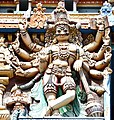Meenakshi Temple: Difference between revisions
Kamal Guha (talk | contribs) (Map) |
CleanupBot (talk | contribs) m (clean up) |
||
| Line 25: | Line 25: | ||
==History== | ==History== | ||
According to Hindu mythology the temple has divine origins. More than 3,500 years ago, [[Indra]] the king of the [[Deva (Hinduism)|devas]] built a temple as a symbol of his devotion to [[Shiva]]. Other gods added more temples and the religious centre started growing. The local king; Kulashekhara Pandya, also built a temple there. His daughter, Meenakshi, had divine symptoms at birth and she married Shiva later. However, it is also believed the oldest amongst the present structures was possibly built in the 7th century by the [[Pandya dynasty]] and later fully developed by the [[Madurai Nayak dynasty]], in the 16th and 17th centuries. This is the temple complex one sees today.<ref name= | According to Hindu mythology the temple has divine origins. More than 3,500 years ago, [[Indra]] the king of the [[Deva (Hinduism)|devas]] built a temple as a symbol of his devotion to [[Shiva]]. Other gods added more temples and the religious centre started growing. The local king; Kulashekhara Pandya, also built a temple there. His daughter, Meenakshi, had divine symptoms at birth and she married Shiva later. However, it is also believed the oldest amongst the present structures was possibly built in the 7th century by the [[Pandya dynasty]] and later fully developed by the [[Madurai Nayak dynasty]], in the 16th and 17th centuries. This is the temple complex one sees today.<ref name= "madurai">{{cite web| url = https://www.khanacademy.org/humanities/art-asia/south-asia/x97ec695a:1500-1850-deccan-south/a/the-meenakshi-temple-at-madurai | title= The Meenakshi Temple at Madurai | work= by Edward Fosmire |publisher= Khan Academy | access-date = 23 October 2023}}</ref> | ||
==The temple complex== | ==The temple complex== | ||
The Meenakshi temple complex is spread over almost 700,000 square feet of land. It has two principal sanctuaries and numerous shrines of varying sizes. It contains about 30,000 sculptures. The two principal sanctuaries are dedicated to Meenakshi and Sundareshwara. Pilgrims bathe in the Golden Lily Tank before engaging in worshipping. The thousand pillared hall is a huge [[mandapam]]. <ref name= | The Meenakshi temple complex is spread over almost 700,000 square feet of land. It has two principal sanctuaries and numerous shrines of varying sizes. It contains about 30,000 sculptures. The two principal sanctuaries are dedicated to Meenakshi and Sundareshwara. Pilgrims bathe in the Golden Lily Tank before engaging in worshipping. The thousand pillared hall is a huge [[mandapam]].<ref name= "madurai"/> | ||
The Meenakhi Temple is a fine example of [[Dravidian architecture]]. It attracts approximately 20,000 people every day. During the 10-day long Tirukalyanam Festival, about a million people visit the temple. It has been declared as the ‘Best Swachh Iconic Place’ (cleanest iconic place) in India. <ref name= | The Meenakhi Temple is a fine example of [[Dravidian architecture]]. It attracts approximately 20,000 people every day. During the 10-day long Tirukalyanam Festival, about a million people visit the temple. It has been declared as the ‘Best Swachh Iconic Place’ (cleanest iconic place) in India.<ref name= "madurai"/><ref>{{cite web| url = https://www.culturalindia.net/indian-temples/meenakshi-temple.html | title= Meenakshi Temple |publisher= Cultural India| access-date = 15 November 2023}}</ref> | ||
==Meenakshi Temple Gallery== | ==Meenakshi Temple Gallery== | ||
Latest revision as of 11:51, 24 November 2023
| Meenakshi Temple | |
|---|---|
| Religion | |
| Affiliation | Hinduism |
| District | Madurai district |
| Deity | Meenakshi (Parvati), Sundareshwar (Shiva) |
| Location | |
| Location | Madurai |
| State | Tamil Nadu |
| Country | India |
| Geographic coordinates | 9°55′13″N 78°07′09″E / 9.920150°N 78.119210°ECoordinates: 9°55′13″N 78°07′09″E / 9.920150°N 78.119210°E |
| Architecture | |
| Type | Dravidian architecture |
| Creator | Pandya dynasty |
Meenakshi Temple (also known as Meenakshi Amman Temple or Meenakshi Sundareshwara Temple) is a Hindu temple in Madurai in the Indian state of Tamil Nadu. The presiding deities are Meenakshi, a form of Parvati, and her consort, Sundareshwar, a form of Shiva. The temple complex has 14 gopurams (gateway towers}, the tallest rising to a height of 51.9 metres (170 feet). The complex has pillared halls with artistic sculptures.[1]
History[edit]
According to Hindu mythology the temple has divine origins. More than 3,500 years ago, Indra the king of the devas built a temple as a symbol of his devotion to Shiva. Other gods added more temples and the religious centre started growing. The local king; Kulashekhara Pandya, also built a temple there. His daughter, Meenakshi, had divine symptoms at birth and she married Shiva later. However, it is also believed the oldest amongst the present structures was possibly built in the 7th century by the Pandya dynasty and later fully developed by the Madurai Nayak dynasty, in the 16th and 17th centuries. This is the temple complex one sees today.[2]
The temple complex[edit]
The Meenakshi temple complex is spread over almost 700,000 square feet of land. It has two principal sanctuaries and numerous shrines of varying sizes. It contains about 30,000 sculptures. The two principal sanctuaries are dedicated to Meenakshi and Sundareshwara. Pilgrims bathe in the Golden Lily Tank before engaging in worshipping. The thousand pillared hall is a huge mandapam.[2]
The Meenakhi Temple is a fine example of Dravidian architecture. It attracts approximately 20,000 people every day. During the 10-day long Tirukalyanam Festival, about a million people visit the temple. It has been declared as the ‘Best Swachh Iconic Place’ (cleanest iconic place) in India.[2][3]
Meenakshi Temple Gallery[edit]
References[edit]
- ↑ "Arulmigu Meenakshi Sundaraswarar Temple, Madurai - 625001, Madurai District [TM031962]". Thirucoil. Retrieved 15 November 2023.
- ↑ 2.0 2.1 2.2 "The Meenakshi Temple at Madurai". by Edward Fosmire. Khan Academy. Retrieved 23 October 2023.
- ↑ "Meenakshi Temple". Cultural India. Retrieved 15 November 2023.








